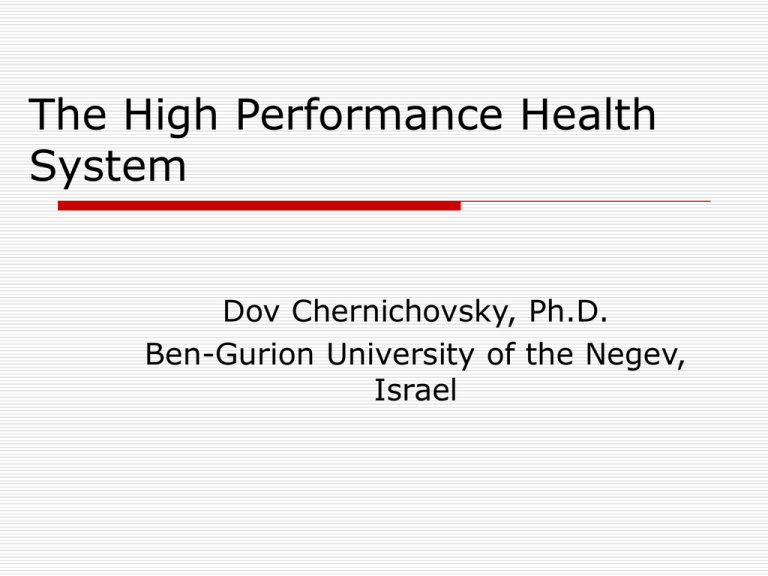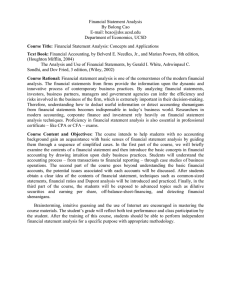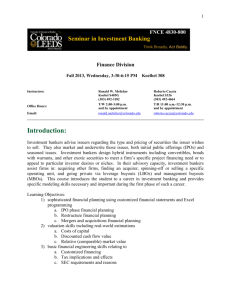The High Performance Health System Dov Chernichovsky, Ph.D. Ben-Gurion University of the Negev,
advertisement

The High Performance Health System Dov Chernichovsky, Ph.D. Ben-Gurion University of the Negev, Israel Objectives of Presentation Articulate goals and objectives of the health care system Examine (some) performance indicators Identify structural features of health systems associated with actual and potentially good performance June 21, 2006 Dov Chernichovsky - Draft 2 Background “The Emerging Paradigm in Health Systems” Study -- Funded by the Commonwealth Fund -- of the health systems of eight developed nations: Australia, Canada, Germany, France, Israel, The Netherlands, the U.K. and the U.S. Audience: U.S. policy makers Approach: technocratic, to the extent possible June 21, 2006 Dov Chernichovsky - Draft 3 Goals & Objectives of Society Regarding the Healthcare System Invest in health, balancing between spending on medical care and on other means to enhance health Objectives: (Health) Equity Cost containment Efficient production of quality medical care Client satisfaction June 21, 2006 Dov Chernichovsky - Draft 4 Health – Life Expectancy (data sources in full paper) Life Expectancy at birth in 2003 (years) Country Female Male Total Population Difference Between Genders 82.8 77.8 80.3 5.0 Canada 82.1´¹ 77.2´¹ 79.7´¹ 4.9 France 82.9 75.8 79.4 7.1 Germany 81.3 75.5 78.4 5.8 Israel 81.8 77.6 79.7 4.2 Netherlands 80.9 76.2 78.6 4.7 United Kingdom 80.7 76.2 78.5 4.5 79.9´¹ 74.5´¹ 77.2´¹ 4.4 Australia United States June 21, 2006 Dov Chernichovsky - Draft 5 Equity – Instrumental Rationale Equitable distribution of medical resources can improve average health Protection of household non-medical consumption from ‘catastrophic’ medical spending June 21, 2006 Dov Chernichovsky - Draft 6 Equity - Equitability of Funding Resources Source of Funding Country General Revenues Social security % of Total Health Spending % of Total Health Spending Private expenditure Score % of Total Health Spending (higher, more equitable) Australia 65.0 0.0 35.0 65.00 Canada 68.4 1.5 30.1 69.45 France 2.5 73.8 23.7 54.16 Germany 9.8 68.4 21.8 57.68 Israel 43.0 27.0 30.0 61.90 Netherlands 4.4 58.0 37.6 45.00 United Kingdom 83.5 0.0 16.5 83.50 United States 31.5 13.0 55.5 40.60 June 21, 2006 Dov Chernichovsky - Draft 7 Cost Containment – (Instr.) Rationale Helps protect household income and spending Contributes to lower production costs, competitiveness, and employment June 21, 2006 Dov Chernichovsky - Draft 8 Cost Containment (a) -Relative Price Increases in Medical Care 160 150 140 Australia 130 Canada France 120 Israel 110 US 100 90 1985 June 21, 2006 1990 1995 2000 Dov Chernichovsky - Draft 2002 9 Cost Containment (b) – Real (General Price Index) Per Capita Growth in Health Spending 275 250 Australia 225 Canada France 200 Germany Israel 175 Netherlands UK 150 US 125 100 1980 June 21, 2006 1985 1990 1995 Dov Chernichovsky - Draft 2001 10 Production Efficiency - Rationale More resources for quality care and other uses June 21, 2006 Dov Chernichovsky - Draft 11 Production Efficiency – Spending Expenditure as a % of GDP Spending Per Capita (US$) Australia 9.3´¹ 2699´¹ Canada 9.9 e 3001 e France 10.1 e 2903 e Germany 11.1 2996 Israel 8.5 1953 Netherlands 9.8 2976 United Kingdom 7.7´¹ 2231´¹ United States 15.0 5635 Country June 21, 2006 Dov Chernichovsky - Draft 12 Client Satisfaction – Client Desire for Reform % Responding about Required Reform Minimal Reform Substantial Reform Total Reform Australia 19 49 30 Canada 20 56 23 France .. .. .. Germany .. .. .. Israel 37 49 13 The Netherlands .. .. .. United Kingdom 25 58 14 United States 17 46 33 Country June 21, 2006 Dov Chernichovsky - Draft 13 Preliminary Conclusions Systems in-between the U.K. and U.S.A do better in balancing health system goals They are more relevant to the U.S.A., anyhow June 21, 2006 Dov Chernichovsky - Draft 14 Principles for Success Universal entitlement Centralized funding of care -- not necessarily by the state budget -- for Equity Cost containment Competition and choice– not necessarily in private markets -- for Efficient production of quality care Client satisfaction June 21, 2006 Dov Chernichovsky - Draft 15 Apparently Successful Dual Internal Market Structure State Regulation Funding Pool, Real or Virtual Non-state Fund holding, OMCC Institutions: Sickness Funds, HMOs, etc. Contracting First Market Purchasing Second Market Providers June 21, 2006 Dov Chernichovsky - Draft 16 Reform Directions Fully Centralized K ↑ OMCC & Provision ↓ Z Transitional poor nations Transitional Economies Europe A The U.S & poor nations P Competitive Out of Pocket, Private June 21, 2006 → Funding ← Dov Chernichovsky - Draft General Revenues, Fully Public 17 Basic Features of Dual Internal Market Enables multiple Lines of accountability Enables pluralism and choice in Form of entitlement Content of entitlement Enables client empowerment vis a vis state, on the one hand, and providers, on the other June 21, 2006 Dov Chernichovsky - Draft 18 Multiple Lines of Accountability Fundraising & Allocation OMCC Institution OMCC Institutions2 Providers Finance Accountability June 21, 2006 Dov Chernichovsky - Draft 19 Multiple Forms of Care Model A Model B OMCC OMCC Primary Care Primary Care Primary care Professional care and hospitalization Model C Model D OMCC OMCC Primary care Professional care and hospitalization June 21, 2006 Professional care and hospitalization Primary care Professional care and hospitalization Dov Chernichovsky - Draft 20 Multiple Content of Entitlement Expansion of Entitlement Private entitlement and finance Discretionary public entitlement, financed by a pre-set portion of public-based finance Core public entitlement – common to all groups June 21, 2006 Dov Chernichovsky - Draft 21 Key Function & Institution Organization and Management of Care Consumption (OMCC) / Competing Budget Holder Basic References Chernichovsky, D. 1995. “Health System Reforms in Industrialized Economies; An Emerging Paradigm”. The Milbank Quarterly Vol. 73, no. 3: 339-372. Chernichovsky, D. 2002. “Pluralism, Choice, and the Sate in the Emerging Paradigm in Health Systems.” The Milbank Quarterly. Vol. 80, No.1:5-40. June 21, 2006 Dov Chernichovsky - Draft 23 Thanks June 21, 2006 Dov Chernichovsky - Draft 24






